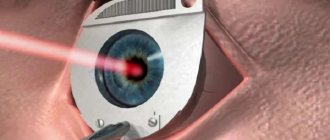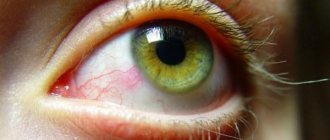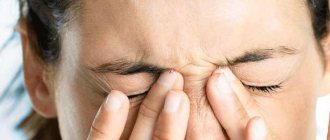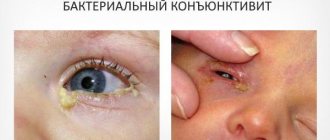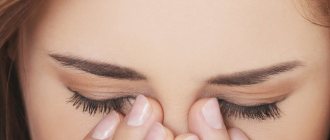- October 20, 2018
- Ophthalmology
- Maria Ivanova
Puffiness under the eyes is a fairly common problem. The cause of swelling under both eyes at once can be the ingestion of too much liquid or salty food, the onset of an inflammatory process in the body, various injuries and diseases, severe tearing and even insect bites. It is important to remember that eye swelling can occur as a result of the spread of pathology. It is necessary to determine exactly why the eyes swell.
State Description
Any swelling brings a lot of discomfort and can greatly disturb a person. A sign of any edema, regardless of the cause of its occurrence, is the accumulation of excessive amounts of fluid in the tissues of the body. A huge number of factors can lead to this condition. Some of them are eliminated quite quickly, while others indicate the presence of dangerous diseases in the body.
If the cause of swelling of the upper eyelid of the right eye is a domestic situation, then the problem can be eliminated quite quickly. In the case where swelling occurs due to an exacerbation of the disease in the body, it is important for the patient to immediately go to see a doctor.
Blepharitis
Blepharitis is a group of ocular inflammatory diseases, the common characteristic feature of which is hyperemia and swelling of the eyelid margins.
The main cause is a staphylococcal infection, which affects the hair follicles of the eyelashes. It spreads in the mucous membranes of the upper respiratory tract, as well as on the epidermis. When staphylococcus gets into the hair follicles of the eyelashes, it provokes the development of blepharitis. The disease also occurs when intestinal bacteria, molluscum contagiosum, yeast-like fungi and other pathogens come into contact with the mucous membranes.
Infectious eye pathologies have one common symptom - when they occur, the eyelid swells and turns red. Depending on the etiology, blepharitis is divided into several types:
- Demodectic. Demodex is a mite 0.2-0.5 mm in size, which is found in the ducts of the meibomian glands, the bases of the hair follicles. Up to 90% of adults are asymptomatic carriers of this parasite. However, when certain circumstances occur, the mite becomes active and gets on the eyelids, as a result of which demodicosis begins to develop. The main signs of demodicosis are the appearance of itching, dryness, burning, and the eyelid swells. The base of the eyelashes is covered with small white scales - these are traces of the vital activity of the Demodex mite.
- Ulcerative. The most severe and dangerous type of blepharitis, difficult to treat. It is characterized by purulent inflammation of the hair follicles of the eyelashes with the formation of crusts. The eyelids swell and hurt when pressed. Due to the accumulation of pus in the follicles, eyelashes often begin to fall out, and in the future their proper growth may be disrupted.
- Seborrheic, or scaly (seborrhea of the eyelids). With this disease, the eyes become swollen and very itchy, and scales of the epidermis and epithelium of the sebaceous glands accumulate on the hyperemic edges of the eyelids. Skin particles are also present on eyebrows and hair. The course of seborrheic blepharitis may be accompanied by loss of eyelashes. The sticky secretion from the follicles sticks the eyelashes together, and sometimes there is profuse lacrimation. In the absence of timely treatment, scaly blepharitis takes a chronic course and can last for many years.
There are other types of blepharitis: rosacea, meibomian. All diseases of this group are characterized by common symptoms: the upper eyelid swells and hurts, and purulent contents are often released. Signs of blepharitis can sometimes be confused with manifestations of another eye pathology - conjunctivitis.
Physiological causes of edema
As a rule, the right eye swells due to eating excessive amounts of fatty, salty, fried or spicy foods. Stagnation of fluid in the tissues of the body often occurs during a late dinner immediately before bedtime - a person’s right eye swells in the morning.
There are other factors that cause severe swelling of the face and eyes. These include:
- drinking alcoholic beverages, smoking;
- an adverse reaction to taking certain medications (including those prescribed by a doctor);
- severe fatigue of the body, regular lack of sleep, violation of the daily routine;
- drinking a large volume of water before going to bed;
- genetic predisposition.
Causes
When the eyes become swollen, it is not only a cosmetic defect, but also sometimes a symptom of some kind of eye disease. Both adults and children face this problem. In most cases, if the eye is swollen, it greatly alarms the person and causes discomfort. However, it is quite possible to eliminate such swelling at home. But why can your eyes swell?
All causes of this unpleasant symptom are divided into internal and external. These include chronic lack of sleep or too much sleep, more than 10 hours, as well as prolonged work at the computer, which increases eye strain. Eyes can also become swollen due to stress or tearing. The fact is that often emotional exhaustion, increased tearfulness and dissatisfaction with one’s own life negatively affect the condition of this organ. If the eyes are swollen, this may also be caused by a late dinner, abuse of alcoholic beverages, water or salty foods.
Other causes of swelling
Another fairly common cause of eye puffiness is low-quality decorative cosmetics, the use of which is important to stop immediately after the first external signs appear. The same applies to creams, lotions, scrubs and other facial products.
Swelling is a fairly common and unpleasant condition, but you can get rid of it quite quickly. To do this, you just need to carefully consider your diet, sleep and rest patterns, as well as the medications you take. The sooner the patient gets rid of the negative factor, the faster the swelling in the eyes will go away.
If we talk about puffiness under a child’s eyes, everything is quite simple. In the first months of life, a newborn cries a lot and often rubs his eyes with his hands. Regular exposure of the eye skin leads to severe swelling and redness. It is important to remember that this can provoke the introduction of a pathogenic infection into the conjunctival sac.
How to get rid of it?
Lack of vitamin K in the body can lead to swollen eyes. Therefore, to solve this problem, you need to include it in your diet. Vitamin K-rich foods include green leafy vegetables, broccoli, carrots, liver and strawberries. It is also necessary for normal blood circulation.
Cold spoons
This method is very simple and effective in getting rid of puffy eyes. It has the ability to plump the skin around the eyes and relax the blood vessels, thereby providing instant relief and de-puffiness. To do this, you must cool five metal spoons for 10-15 minutes in the refrigerator. Then place the spoon over your eyes and hold it until it warms up, then replace it with a cold one.
Water
Drinking extra water is one of the easiest ways to get rid of puffy eyes. You will be less likely to retain water, which causes puffy eyes, if your body is well hydrated. Additionally, drinking water regularly can help flush out toxins from the body. It's best to drink at least 8 glasses of water every day to maintain balance. Sugary drinks and caffeine should be avoided as they cause dehydration. Salt also retains moisture in the body, so you should reduce its amount to reduce swelling.
All essential oils are very beneficial for treating puffy eyes. Chamomile has anti-inflammatory properties, relieves irritation, soothes swelling, and lavender oil has a soothing and softening effect on the skin. Lemon oil, on the other hand, helps in reducing tension and has natural antioxidants. These oils will tone the skin around the eyes and make it healthy and fresh.
To do this, take 1 drop each of lemon, lavender and chamomile oils and 1 tsp. water, mix the oils together and then add water. Now massage the mixture onto the skin around your eyes before going to bed. Leave it overnight. To remove bags under the eyes and puffiness, repeat this procedure every night.
Coffee
This method is also effective for relieving eye puffiness. Caffeine present in coffee has anti-inflammatory properties that reduce swelling. The coconut oil in the recipe moisturizes the skin and gives it a natural glow, while the black pepper powder stimulates blood circulation and makes the skin under the eyes healthier.
For this purpose, mix 1 teaspoon of coconut oil, 1/2 teaspoon of ground coffee beans and 1 pinch of ground black pepper. Apply this mixture on the skin around the eyes. After 10-12 minutes, carefully rinse the mixture with warm water or a wet towel. Use this recipe several times a week to get rid of puffiness.
cucumbers
One good remedy for puffy eyes is to use chilled cucumbers. Containing astringents and enzymes, they tighten the skin and relieve inflammation. In addition, they remove dark circles and wrinkles around the eyes. To do this, take a cucumber and cut it into thick slices. Then chill the cucumber slices for 10 minutes in the refrigerator. Place the cold slices on your eyelids for ten minutes. Repeat the procedure a couple of times a day.
Tea bags
Typically, black and green tea bags have the ability to soothe irritated and puffy eyes, as well as reduce redness and inflammation. For this remedy, take two used tea bags and place them in the refrigerator for 30 minutes. While lying down, place the prepared tea bags on your eyelids for 10-15 minutes. Can be performed several times a day.
Egg white mask
Egg white is an excellent ingredient in many skin care recipes and is also effective on puffy eyes. Additionally, it can smooth out wrinkles and bags under the eyes thanks to its skin tightening properties. To do this, take an egg white and beat it thoroughly in a bowl until it becomes stiff. Apply egg white to your eyes using a cloth or soft sponge. Leave the mask until completely dry and rinse off after fifteen minutes with warm water. Use once a day and you will notice results within a few days.
Being rich in antioxidants and vitamins, aloe vera is effective in reducing puffiness under the eyes. It also has a rejuvenating effect and tones the skin. For this recipe, take some fresh aloe pulp and apply it to the skin around your eyes. Leave to dry for 8-10 minutes and then rinse with cold water. It is recommended to use this product 2 times a day.
Salty water
Salt water can relieve inflammation. Remember to control your intake of foods with a lot of salt, because salt-rich foods cause puffiness. For the salt recipe, mix ½ teaspoon salt with 1 quart warm water in a bowl. Soak cotton balls in salt water and then place them on your eyelid. Leave it for a while. Apply every night before bed.
Increased fatigue
Why do my eyes swell? Puffiness of the eyes can appear as a result of severe fatigue of the body, regular lack of sleep, when a person does not monitor his state of health.
Swelling under the eyes will be the first sign that something is wrong in the body and you should reconsider your lifestyle. For example, start sleeping 8 hours a day, evenly distribute rest and work activities, and take a short vacation. If this is the reason, the swelling will go away after several days of proper rest.
If it is important to get rid of puffiness from the eyes as soon as possible, then the best way to do this is to take a cooling shower and apply cool compresses to the eyes. Most often, the swelling goes away almost completely. If, after some time, a person begins to overstrain his body again and gets tired, the swelling will appear again and in this case it will be even more difficult to eliminate it.
Nature of edema
If it becomes noticeable that your eyes are swollen, you need to determine the nature of this process. This could be due to some kind of inflammation, or the cause is not inflammatory in nature. In case of inflammation, the skin of the eyelid becomes red, body temperature may be elevated, and pressure on the eyelid may cause pain. The cause of this process may be barley, furunculosis, erysipelas. When you press on the inflamed eyelid in these diseases, you can feel a small lump.
If the cause is not inflammation, the skin of the eyelid becomes pale; when pressing on it, the person does not feel pain. Under such circumstances, not only the eyelids swell, but also other parts of the body. Swollen eyelids can be the cause of disease in the eyelids themselves. The upper area of the eye may swell due to swelling of the eyelids, also called squamous cell carcinoma.
Wrong diet
Eating fast food and other junk food can cause severe swelling, primarily in the eye area. If for certain reasons a person has greatly exceeded the level of consumption of junk food, his body may react to this with swelling of varying degrees.
This also applies to the level of salt in the body. Salt attracts a large amount of fluid and leads to the formation of edema. If spicy food is consumed for the first time, the process of intoxication may begin in the human body, to which swelling will become a protective reaction.
If it is poor nutrition that has led to the appearance of swelling, it is important for a person to completely abstain from consuming harmful foods for several weeks. You need to start taking a large volume of fluid, which will help speed up the process of removing excess substances from the body. If all the rules are followed, the symptoms of swelling will disappear within a few hours.
How to remove swelling from the eyes? In this case, tea lotions will help get rid of this condition. To do this, it is best to use already used, squeezed out bags of plain black tea.
Treatment of swollen eyelids
The problem of swollen eyes should be solved by an infectious disease specialist, an allergist and an ophthalmologist.
. The main emphasis is on ointments, drops and other means of local action. In the event that the eyes are swollen due to some internal malfunction, the doctor may prescribe allergens, steroids, and blood circulation-accelerating medications. Traditional recipes can also help solve the problem.
Special drops and ointments
If the problem is infectious
, then it is advisable to resort to a course of therapy with Sulfacyl drops. This drug is especially effective in the initial stages of the disease. It minimizes the activity of harmful microorganisms, easing the course of blepharitis and conjunctivitis. You need to use it three times a day, placing three drops in each eye. If the edema is in an advanced stage, doctors prescribe the following medications:
It is advisable to use ointments when swelling of the eyelids occurs as a supplement to drops and traditional medicine. Oxolinic, heparin, hydrocortisone and have excellent effectiveness. The effect can be enhanced if sterile bandages are applied to the eyes after each treatment procedure.
It is necessary to dwell in more detail on each of the ointments:
Folk recipes
In most cases, swelling of the eyes occurs after sleeping in the morning.
. If the problem appears occasionally, then the reasons for this phenomenon include excessive fluid intake in the evening or at night, prolonged crying, overwork of the eyeballs or a cold. Traditional medicine can quickly cope with swelling:
Effective exercises
If significant swelling is not observed, then it will be useful to do special exercises
which help strengthen the eye muscles. In addition, eye gymnastics improves blood circulation, saturates the visual organ with oxygen, eliminates inflammation and soothes the skin.
To do this, it is useful to rotate the pupils counterclockwise, sideways and in the opposite direction. The exercise should be done at least twenty times a day.
The following exercise also has a good effect
: Look down, then up, and back to the floor. Next, try to draw a conditional line from the lowest corner of the room to the highest. After that, try to draw a rhombus, triangle, oval and other geometric shapes with your eyes.
As a useful addition, it is advisable to massage the eyelids with your fingers. In this case, you need to move without haste, painstakingly processing all areas. Remember that this does not require pinching, tapping or patting, since the skin in this area is very sensitive and thin.
It is important to promptly notice that swelling has appeared in the eye area, otherwise treatment of eye swelling will be very difficult. Therapy must be comprehensive
. One way or another, this problem can be solved, and it does not pose any danger to life.
Attention, TODAY only!
Swelling of the eyelids is considered quite common. It can be characterized as an abnormal increase in fluid in the tissue of the eyelids. The main age group for this disease is people over 30 years of age, but young children are also susceptible to this problem. Infrequent swelling of the eyelids does not carry any serious consequences. It only causes discomfort to the person who is faced with it.
Allergic reaction
Allergies in a person can appear unexpectedly or after a certain period of time. An allergic reaction can begin as a result of accidental contact with the eyes of detergent or household chemicals, when using low-quality cosmetic products, unknown food, or when exposed to plant pollen.
Usually an allergic reaction to an irritant occurs very quickly. As soon as the impact of the negative factor stops, the condition of the eye skin returns to normal and the swelling goes away.
In this case, answering the question of how to remove swelling from the eyes is quite simple. To do this, it is important to stop exposure to the allergic factor and prevent the development of allergies. It is recommended to take a strong antihistamine, including eye drops. Edema can be cured quite quickly if you approach this condition responsibly.
Conjunctivitis
There are three types of this eye inflammation: bacterial, viral and allergic. Each of them has its own symptoms, but there is a common one: the eyes become inflamed and the eyelids swell, and they become very red. Let's look at how conjunctivitis of different etiologies differs.
If the inflammation of the eyelids also produces thick pus, this may also indicate the development of bacterial conjunctivitis. It is caused by various bacteria - staphylococci, streptococci, chlamydia, as well as bacilli and fungi. The disease poses a great danger to the health of the visual organs. Some types, for example, gonococcal and chlamydial, when chronic, can lead to clouding of the cornea, the formation of ulcers on it, and scars on the upper eyelid. It is very difficult, sometimes impossible, to cure such consequences.
Viral conjunctivitis is the result of various viruses entering the mucous membranes - the nose, mouth, eyes. Often the disease develops against the background of influenza or ARVI.
The main symptoms of the pathology look like this:
- the eyelid swells and hurts;
- ulcers form on the ciliary edges;
- lymph nodes become inflamed;
- there is a feeling of “sand” in the eyes, dryness, photophobia.
Allergic conjunctivitis develops when any irritant to the body comes into contact with the skin or mucous membrane of the eyes. Here are the reasons that can provoke it.
- Seasonal rhinoconjunctivitis (hay fever) is the body’s reaction to pollen from flowering plants. The spring-summer period is a difficult time for allergy sufferers; they are forced to constantly take antihistamines, go outside less often, trying to protect themselves from pollen.
- Room dust - it often contains spores of various fungi, which are powerful allergens.
- Wool, fluff, saliva of pets.
- Caring and decorative cosmetics that are applied to the upper eyelid of the eyes and the skin around them: mascara, eye shadow, as well as creams, gels and other products.
- Household chemicals.
- Medications.
- Food products.
Increased room temperature
There is an opinion that stuffiness in the room can provoke swelling. Most often, swelling due to high temperature appears due to problems with heat exchange in the body, for example, if a person is in a room with high humidity that is not ventilated for a long time. In addition, stuffiness can intensify the above-described causes of eye puffiness.
To eliminate puffiness at high temperatures, you should go to a cool room, wash with cold water or apply a special compress for the eyes. To prevent swelling in hot weather, you should regularly go into cool rooms, avoid eating too salty foods and drink the optimal amount of liquid.
Possible eye diseases
Why is there a lot of swelling under my right eye? If the cause of this condition is not clear, then in order to avoid worsening the condition, it is important for the patient to see a doctor as soon as possible. Only the attending specialist, after conducting a comprehensive diagnosis, will be able to make an accurate diagnosis and prescribe effective treatment. In addition to physiological ones, there are also pathological reasons for the development of an unpleasant condition.
Some patients, without determining the exact cause of the deterioration of their condition, begin to use diuretic drugs. This approach is wrong - self-treatment can only worsen the condition.
If swelling in the eyes does not go away over a long period of time, it is important to immediately undergo a comprehensive study that will help determine the presence of a dangerous disease.
During diagnostic procedures, the doctor can identify the following dangerous diseases:
- large-scale damage to the kidneys and liver;
- problems with the functioning of the cardiovascular system;
- skin damage;
- eye diseases, which are hernial sacs;
- mental disorders, regular overexertion;
- lack of vitamins in the body;
- blood diseases.
This is not a complete list of reasons. It is impossible to get rid of such external manifestations until the main disease is eliminated. Only after eliminating the root cause of the disease will the skin condition be restored and the eyes will not look too swollen.
If we talk about vitamin deficiency, then the swelling in the eyes does not go away throughout the day. In this case, there is no need to worry, but the problem cannot be ignored, since it will not go away on its own. Experts recommend adding as many fresh fruits and vegetables to your diet as possible and including vitamin complexes.
A person’s left eye may swell for another reason – problems with the functioning of the myocardium. These include problems with the functioning of the heart and blood vessels, such as arrhythmia, arterial hypertension, angina pectoris, and chronic heart failure.
The cause of swelling of the right eye is most often problems with the functioning of the kidneys or liver. In any case, an abnormal condition is considered, which is important to promptly treat with effective conservative methods. This problem cannot be ignored, since in case of serious illnesses it can even lead to hospitalization of the patient.
Common reasons why the eye hurts and the upper eyelid is swollen
Severe swelling that does not go away on its own within several days is a symptom of the development of a pathological process. The causes of inflammation of the upper eyelid are the following conditions:
- infection of a viral or bacterial nature: barley, cellulitis, blepharitis, conjunctivitis;
- mechanical injury;
- allergy;
- a bite of an insect.
If something gets in your eye
The mucous membranes of the organ of vision are sensitive, therefore, when small particles enter the eye, an acute reaction begins:
- a person feels the presence of a foreign body;
- tear production increases;
- the eye reflexively closes, forced expansion of the eyelids leads to pain and muscle spasm;
- the patient feels sharp pain;
- Redness of the sclera and swelling are observed.
If rinsing the eye with clean water does not produce results, contact a doctor to remove the foreign particle. After eliminating the cause of irritation, you should visit an ophthalmologist to rule out mechanical injury to the eyes and deterioration of vision.
IMPORTANT. When prescribing antibacterial therapy, you should not neglect medical recommendations. Antimicrobial eye drops will help prevent infection.
Impact injury
Blunt injuries from a blow are accompanied by the appearance of hematomas due to rupture of capillary vessels. A special anti-inflammatory eye ointment and a cold compress will help eliminate swelling in the affected area.
Normally, pain and swelling disappear within 3 days. If during this period the pain syndrome remains at the same intensity and inflammation, you should immediately consult a doctor. It will take 1-3 weeks for the skin to recover after hemorrhage, depending on the severity of the injury.
Allergy
Often the eyelids swell due to allergies to pollen, food or metal dust. Irritation of the immune system can be distinguished from other ophthalmological diseases by the following signs:
- severe itching of the eyelids;
- redness;
- swelling of the lower and upper eyelids;
- severe tearing.
Carrying out diagnostic activities
With inflammatory edema, a person may experience additional symptoms:
- severe redness;
- pathological discharge;
- severe pain, especially when blinking.
Allergic swelling is manifested by mucous-watery discharge in a huge volume. There is also a significant increase in lacrimation. When an injury occurs, swelling forms at the site of injury.
Diagnostic measures are carried out to determine the main cause of the development of this condition. It is quite easy to determine swelling even with an external examination. Experts most often prescribe the following diagnostics:
- assessment of allergological status;
- biomicroscopy to detect inflammation in the eyeball;
- detection of blood clotting;
- biochemical blood tests to determine kidney function;
- Ultrasound examination to detect cardiac ejection fraction.
Treatment of the condition
Treatment of inflammation will include the following therapeutic measures:
- taking antibiotics;
- taking anti-inflammatory drugs.
For allergic-type edema, doctors prescribe antihistamines and anti-inflammatory drugs to patients. Swelling resulting from injury is treated by applying special bandages and antibacterial ointment (Venitan gel, Dr. Theis Venen gel, Vishnevsky ointment). With a congestive form of edema, the doctor prescribes treatment for the main disease.
Treatment
Treatment is not carried out if swelling of the eyelids appears due to poor diet or drinking too much water. To speed up the recovery process, apply a cold compress to the affected area.
Antihistamines help get rid of allergic reactions and inflammation after an insect bite:
- Suprastin;
- Claritin;
- Tavegil;
- Loratadine.
Drugs from this group suppress the synthesis of histamine, which leads to the development of edema. As a result of proper medication use, you can get rid of the symptoms of allergies, headaches, coughs and inflammation of the mucous membranes.
In the presence of concomitant diseases of the cardiovascular system, leading to swelling of the eyelids, antihypertensive drugs are prescribed to normalize blood pressure. If the kidneys are damaged, excess fluid is removed by taking diuretics.
To restore liver function, hepatoprotectors are taken. Symptomatic treatment of swelling and pain in the eyes is carried out using drops or ointments from a number of non-steroidal anti-inflammatory drugs.
IMPORTANT. The medications should be taken under the supervision of the attending physician. Consultation with a specialist is necessary for swelling of the eyes that does not go away within 3-4 days.
Before using alternative medicine, you should consult a specialist. Folk remedies can only be used with the permission of the attending physician in parallel with drug therapy.
Taking medications
If the lower eyelid of the right eye swells too often, it is important for the patient to contact an ophthalmologist, who, after diagnostic measures, will make an accurate diagnosis and prescribe effective treatment. In this condition, it is important to begin intensive conservative treatment with the prescription of individual medications.
Many patients ask about the causes of swelling under the right eye and what to do in a particular situation. This condition requires rapid removal of harmful components from the body, as well as limiting contact with the irritant. After which you should take a course of antihistamines, including various drops, which after 3-5 days will help normalize the condition of the eyes and relieve swelling. To prevent this condition in the future, you should avoid repeated exposure to allergens.
Additionally, the doctor recommends taking a course of diuretics to eliminate excess fluid from the patient’s body. The main treatment drug should be chosen together with the doctor. A good effect can be achieved from taking hawthorn. A decoction of dry herbs should be prepared according to the instructions, otherwise there will be no effect.
Swelling of the eyes due to conjunctivitis
The conjunctiva of the eye is a thin layer of tissue that increases in size when the inflammatory process begins. The main symptom of conjunctival edema is a feeling of discomfort in the eye, something foreign inside, severe swelling, itching, and tearing.
With puffiness, the upper and lower eyelids become very swollen, pastyness occurs, and touching the sore eye causes discomfort.
There are some differences between allergic and bacterial inflammation of the conjunctiva. With allergic swelling, the surface of the mucous membrane will be too dry and will provoke a feeling of itching and burning. In the second case, the conjunctiva may be covered with purulent discharge, as if clouded. In an allergic process, the inflammation will be pronounced; in a viral process, it will bring pain and severe discomfort.
Allergy
If a person's eyes are swollen, this may indicate an allergic reaction, which is also called angioedema. In this case, the eyelids swell very quickly, and the swelling goes away at the same speed. Such swelling cannot be ignored, but discomfort under such circumstances occurs quite rarely. Any allergen can affect this reaction, such as dairy or citrus products, various berries or plants, as well as fish and other products. In case of an allergic reaction, it is mainly the upper eyelids that swell.
Application of drops
Drops for the treatment of conjunctival swelling will be selected by the attending physician after diagnostic measures (Vizin, Cromohexal, Allomide). Eye drops should be carried out as follows:
- prepare cotton pads, prescribed drops, a mirror;
- using a damp cotton pad, remove discharge, if any, and disinfect the outer edge of the eyelid;
- With your thumb and forefinger, gently pull back the lower edge of the eyelid and use a pipette to drop the required amount of solution into the space between the lower eyelid and the front surface of the eyeball;
- then lower the eyelid, blink a couple of times, evenly distributing the drops over the surface of the conjunctiva.
In this condition, you can also use a warm compress. It is well suited for combating swelling due to bacterial conjunctivitis, helps increase blood circulation and eliminates the inflammatory process.
ethnoscience
Many people ask the question: “a swollen eye, what should I do?”, there are some simple recommendations on how to eliminate swelling at home:
- Cold compresses made from green or black tea will reduce swelling.
- For inflammatory diseases, apply a cotton pad soaked in chamomile decoction.
- Barley can be effectively treated with calendula decoction lotions.
- To relieve the symptoms of a swollen eye due to an insect bite, you can make a compress for 10-15 minutes with a soda solution.
- A cold mask, rubbing with ice cubes, and a contrast shower produce a good effect.
- If you need to quickly eliminate swelling caused by intense crying, stress, you need to finely chop parsley leaves and apply to your eyelids for 20 minutes.
- Fresh cucumber rings quickly help in the fight against swelling after excessive consumption of strong alcoholic beverages.
- Rosehip decoction also helps effectively; it has a diuretic effect, which allows you to remove excess fluid from the body.
- A special massage will quickly get rid of swelling. Using light massaging movements in a circle, massage the area from the bridge of the nose to the temples, first along the upper, then along the lower eyelid.
